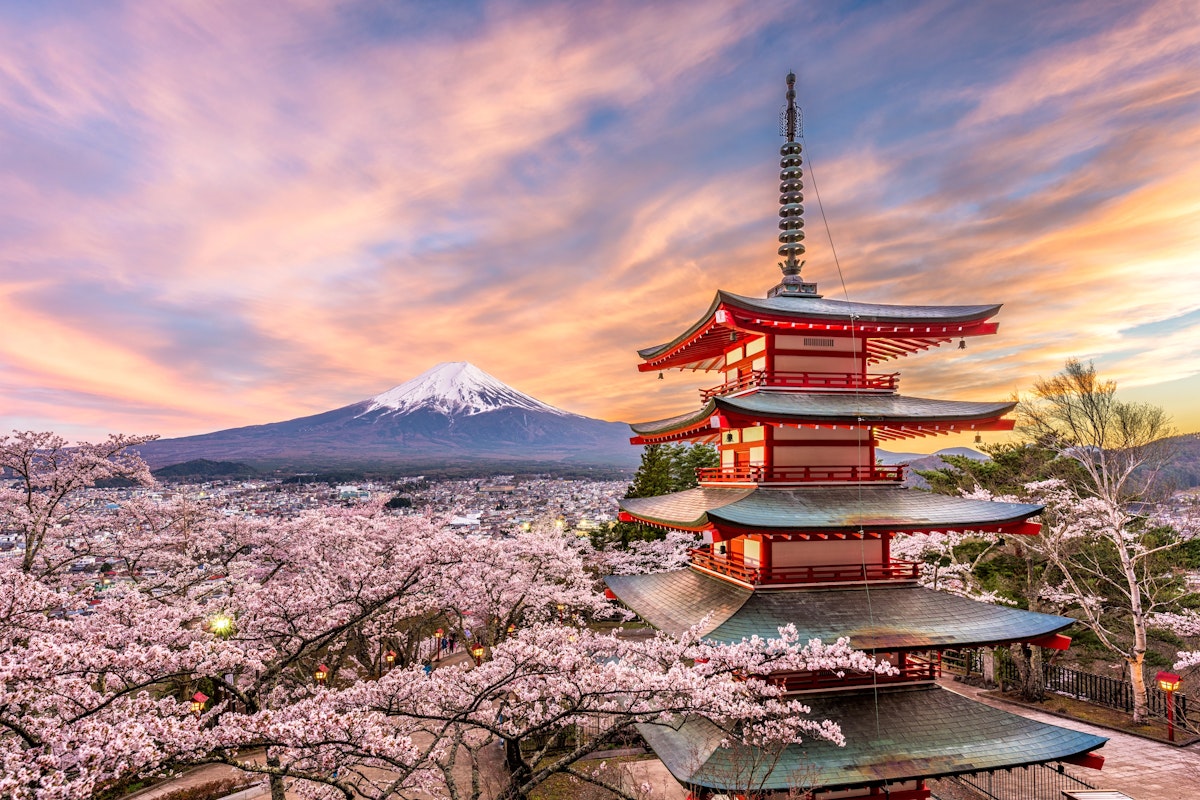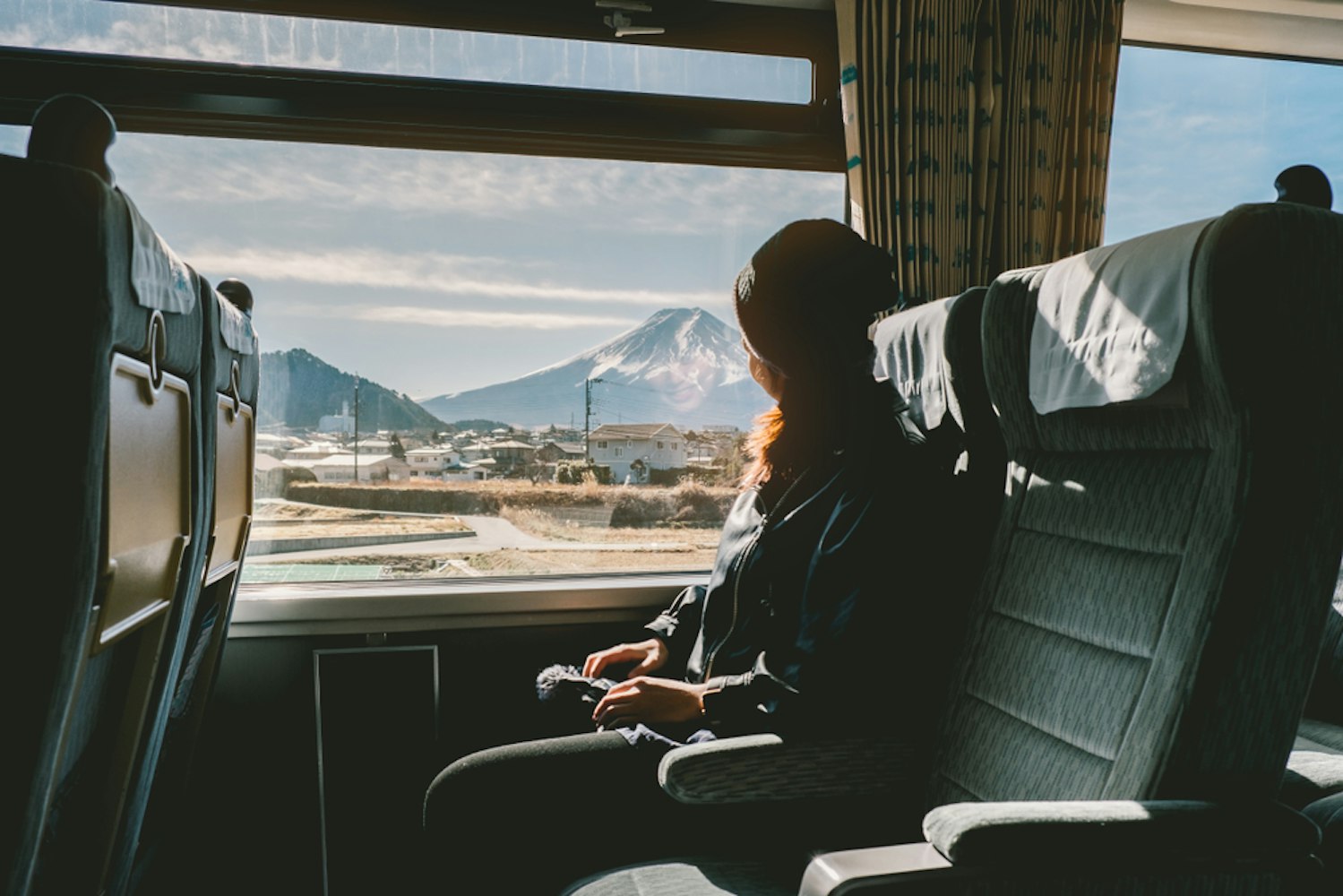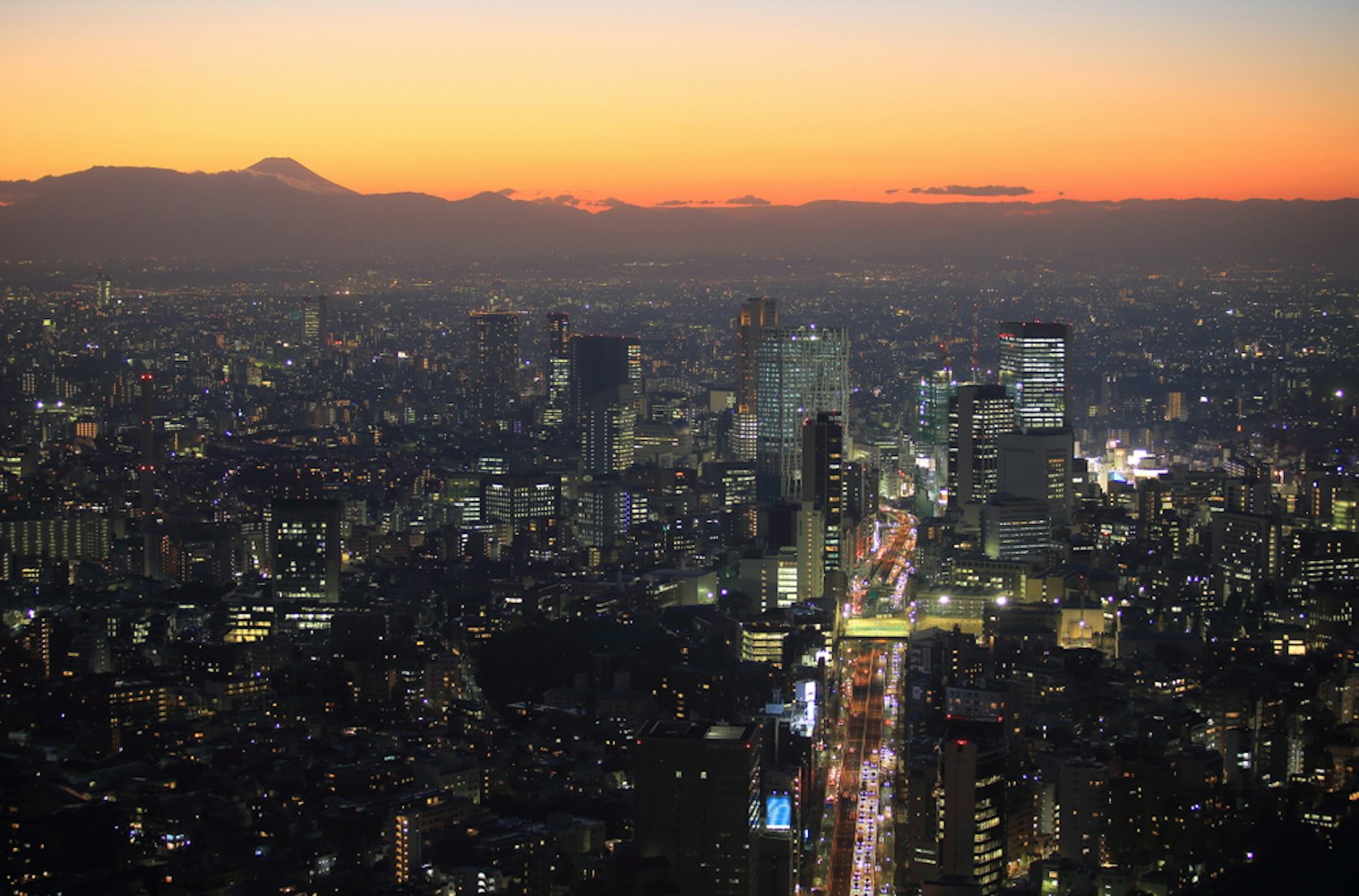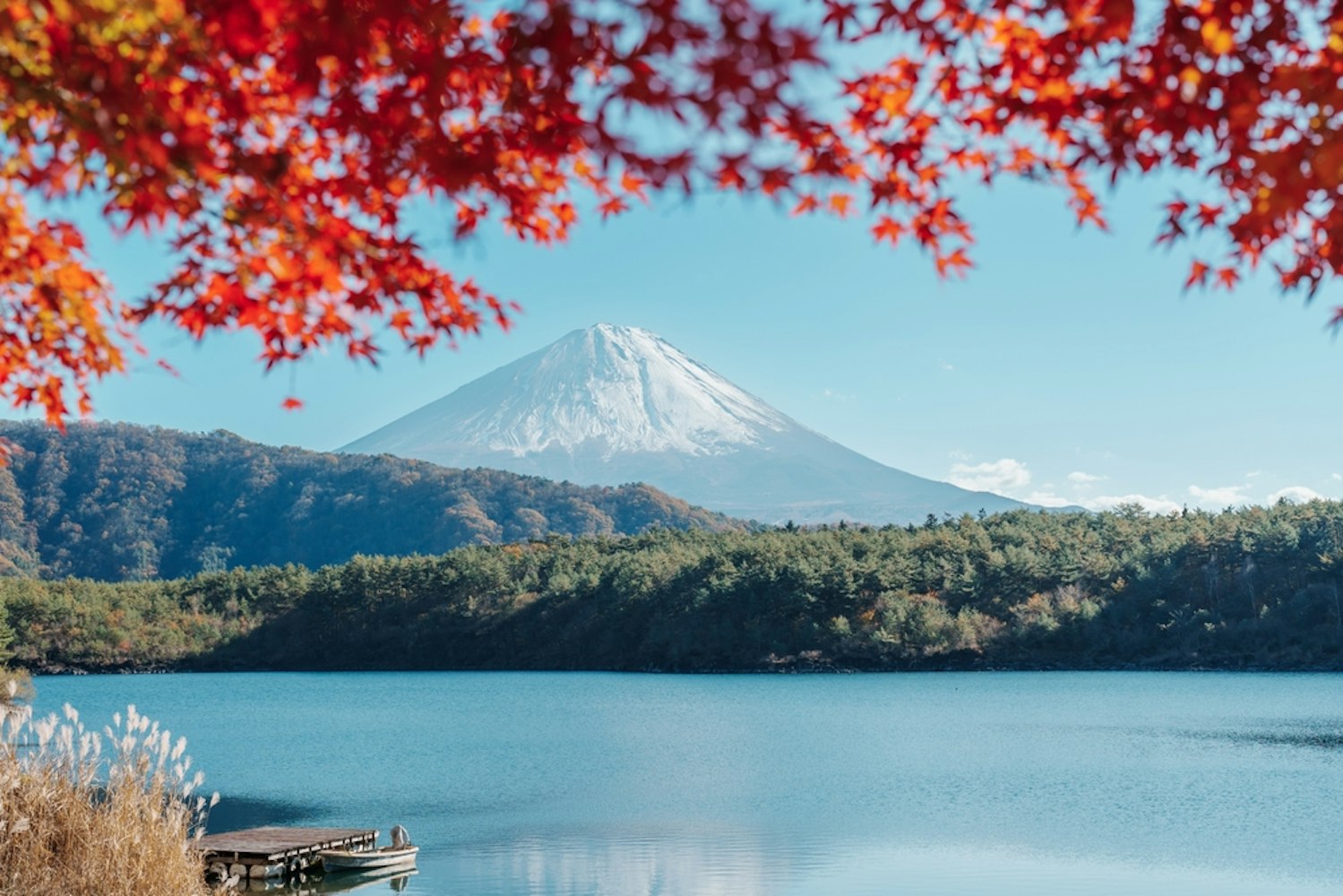

สําหรับนักท่องเที่ยวที่ต้องการชมภูเขาไฟฟูจิอันเป็นสัญลักษณ์จาก โตเกียวการผจญภัยผ่านถนนที่พลุกพล่านไปยังจุดที่เงียบสงบและซ่อนเร้นอาจฟังดูเหมือนการเดินทางภายในการเดินทาง ยอดเขาที่สูงที่สุดของญี่ปุ่นซึ่งมองเห็นได้จากส่วนต่างๆ ของโตเกียว มอบประสบการณ์ที่น่าทึ่งโดยไม่ต้องเดินทางไปยังภูเขา
ในคู่มือนี้ เราจะสํารวจจุดชมวิวลับ ตัวเลือกการเดินทางที่ดีที่สุด และเคล็ดลับในท้องถิ่นที่จะช่วยให้คุณค้นพบทิวทัศน์อันน่าหลงใหลของภูเขาไฟฟูจิจากโตเกียว ไม่ว่าคุณจะเป็นแฟนตัวยงของรถไฟแบบดั้งเดิม รถไฟหัวกระสุนที่วิ่งเร็ว หรือการนั่งรถบัสชมทิวทัศน์ ก็มีตัวเลือกสําหรับนักเดินทางทุกคน
ภูเขาไฟฟูจิ ตั้งอยู่ห่างจากโตเกียวไปทางตะวันตกเฉียงใต้ประมาณ 100 กิโลเมตร (62 ไมล์) ครอบคลุมจังหวัดยามานาชิและจังหวัดชิซุโอกะ ภูเขาไฟฟูจิสามารถมองเห็นได้จากสถานที่ต่างๆ ในโตเกียวในวันที่อากาศแจ่มใส โดยเฉพาะอย่างยิ่งในช่วงฤดูหนาวที่อากาศแจ่มใสและท้องฟ้าแจ่มใส
โดยทั่วไปการเดินทางจะใช้เวลาสองถึงสามชั่วโมง ขึ้นอยู่กับรูปแบบการขนส่งและเส้นทางของคุณ ตัวเลือกต่างๆ ได้แก่ รถไฟหัวกระสุน รถไฟด่วน และบริการรถบัสจากสถานีหลักของโตเกียว

ก่อนสํารวจสถานที่ชมในท้องถิ่นของโตเกียว ภูเขาไฟฟูจิการทําความเข้าใจวิธีการเดินทางต่างๆ เพื่อเข้าใกล้ภูเขามากขึ้นจะเป็นประโยชน์
สถานีโตเกียวไปยังสถานีชินฟูจิบนชินคันเซ็นโทไคโดเป็นหนึ่งในตัวเลือกที่เร็วที่สุด โดยสามารถเดินทางด้วยรถไฟหัวกระสุนได้โดยตรงในเวลาประมาณ 40-50 นาที
สําหรับผู้ถือบัตร JR Pass การนั่งรถไฟ JR สาย Chuo จากสถานีชินจูกุไปยังสถานี Otsuki และเปลี่ยนไปใช้รถไฟสาย Fujikyu Railway จะพาคุณไปยังพื้นที่ทะเลสาบทั้งห้าของฟูจิและสถานีคาวากุจิโกะ
สถานีคาวากุจิโกะสามารถเดินทางไปยังพื้นที่ทะเลสาบฟูจิทั้งห้าและจุดชมวิวอื่น ๆ ในบริเวณใกล้เคียงได้อย่างง่ายดาย ซึ่งเหมาะสําหรับนักท่องเที่ยวที่ต้องการชมยอดเขาที่มีชื่อเสียงของญี่ปุ่นอย่างใกล้ชิด
มีรถบัสสายตรงจากโตเกียวไปยังภูเขาไฟฟูจิวิ่งบ่อยครั้ง โดยออกเดินทางจากศูนย์กลางหลัก เช่น สถานีชิบูย่าสถานีโตเกียว และสถานีชินจูกุ โดยทั่วไปจะมาถึงในเวลาประมาณ 2-2.5 ชั่วโมง
รถบัสทางหลวงจากสถานีชินจูกุไปยังสถานีคาวากุจิโกะเป็นเส้นทางยอดนิยมและคุ้มค่าเหมาะสําหรับผู้ที่มองหาความสะดวกสบายสูงสุดโดยไม่ต้องเปลี่ยนสาย
สถานีขนส่ง Fuji Q Highland เป็นอีกหนึ่งจุดจอดสําหรับรถบัสที่ให้บริการออกเดินทางบ่อยครั้ง ช่วยให้นักท่องเที่ยวเดินทางไปยังจุดหมายปลายทางยอดนิยมรอบภูเขาไฟฟูจิได้อย่างง่ายดาย เช่น พื้นที่ทะเลสาบฟูจิทั้งห้า
การเช่ารถเหมาะอย่างยิ่งสําหรับการสํารวจพื้นที่ตามอัธยาศัย โดยปกติการขับรถจากโตเกียวไปยังภูเขาไฟฟูจิจะใช้เวลาประมาณ 2 ชั่วโมง ขึ้นอยู่กับการจราจร
มีไกด์นําเที่ยวสําหรับนักท่องเที่ยวที่แสวงหาประสบการณ์ที่เป็นระเบียบ ทัวร์ส่วนใหญ่ครอบคลุมภูมิภาคทะเลสาบฟูจิทั้งห้าและแวะที่จุดชมวิว เช่น ทะเลสาบคาวากุจิและสถานีที่ 5 ซึ่งเป็นจุดเริ่มต้นของ เส้นทางโยชิดะ ในช่วงฤดูปีนเขาอย่างเป็นทางการ

การสํารวจจุดชมวิวที่ซ่อนอยู่ของโตเกียวเพื่อชมทิวทัศน์ของภูเขาไฟฟูจิที่ไม่มีสิ่งกีดขวางอาจคุ้มค่า ต่อไปนี้คือความลับที่ดีที่สุดของโตเกียวสําหรับการชมภูเขาไฟฟูจิ ซึ่งคุณสามารถหลีกเลี่ยงฝูงชนในขณะที่ยังคงมองเห็นภูเขาอันเป็นสัญลักษณ์ของญี่ปุ่น
Roppongi Hills Mori Tower ตั้งอยู่ใจกลางกรุงโตเกียวเป็นสถานที่ที่ยอดเยี่ยมในการชมภูเขาไฟฟูจิ จากจุดชมวิว คุณสามารถเพลิดเพลินกับทัศนียภาพอันงดงามของโตเกียวทาวเวอร์ และในวันที่อากาศแจ่มใส ภูเขาไฟฟูจิในระยะไกล
คําแนะนําจากวงใน: พระอาทิตย์ตกดินให้ทัศนียภาพที่ยากจะลืมเลือนเนื่องจากภูเขาปรากฏเป็นเงาตัดกับท้องฟ้าที่มีสีสัน
หอดูดาวฟรีในชินจูกุแห่งนี้ให้ทัศนียภาพอันงดงามของภูเขาไฟฟูจิในวันที่มองเห็นได้ดี ชั้น 45 ของอาคารมีมุมมองที่ไม่เหมือนใครเหนือทิวทัศน์ของเมือง โดยมีภูเขาไฟฟูจิโผล่ขึ้นมาราวกับภาพลวงตาบนขอบฟ้า
สิ่งที่ควรรู้: ตรวจสอบเว็บไซต์ของอาคารสําหรับเวลาเปิดทําการและอาจปิดทําการ เนื่องจากจุดยอดนิยมแห่งนี้สามารถดึงดูดทั้งคนในท้องถิ่นและนักท่องเที่ยวได้
หากต้องการผสมผสานระหว่างธรรมชาติและการชมภูเขาไฟฟูจิ ให้ไปที่ภูเขาทาคาโอะ ภูเขาเล็ก ๆ แห่งนี้ตั้งอยู่ห่างจากสถานีโตเกียวประมาณ 1 ชั่วโมงโดยรถไฟ เป็นจุดหมายปลายทางยอดนิยมของคนในท้องถิ่น
ยอดเขามีสภาพแวดล้อมที่เงียบสงบในการชมภูเขาไฟฟูจิ โดยเฉพาะอย่างยิ่งในช่วงฤดูใบไม้ร่วงที่ใบไม้บานสะพรั่งด้วยสีสัน
เคล็ดลับการเดินทาง: บัตร Japan Rail Pass สามารถครอบคลุมการโดยสารรถไฟจากสถานีชินจูกุไปยังสถานี Takaosanguchi โดยรถไฟสาย JR Chuo
จุดชมวิวที่มักถูกมองข้าม หอดูดาวบนชั้น 25 ของศูนย์ราชการบุนเคียว มีทิวทัศน์อันกว้างไกลของโตเกียวโดยมีภูเขาไฟฟูจิเป็นฉากหลัง
เคล็ดลับสําหรับมือโปร: เช้าตรู่เป็นเวลาที่ดีที่สุดสําหรับการมองเห็นที่ไม่มีสิ่งกีดขวาง เนื่องจากคุณภาพอากาศและแสงโดยทั่วไปจะเหมาะสมที่สุด
สําหรับผู้ที่ต้องการชมวิวริมน้ํา สะพานสายรุ้งและบริเวณหาดโอไดบะจะให้มุมมองอันน่าหลงใหลของภูเขาไฟฟูจิ เดินไปตามสะพานหรือผ่อนคลายบนชายหาดในขณะที่เพลิดเพลินกับทิวทัศน์อันเป็นเอกลักษณ์ของภูเขาที่ล้อมรอบด้วยเส้นขอบฟ้าของโตเกียว
ดีแล้วที่รู้: ตอนเย็นเหมาะอย่างยิ่ง เนื่องจากสะพานสว่างไสว เพิ่มสัมผัสมหัศจรรย์ให้กับทิวทัศน์

แม้ว่าโตเกียวจะมีจุดชมวิวฟูจิที่ยอดเยี่ยม แต่การเดินทางไปยังพื้นที่ภูเขาแบบไปเช้าเย็นกลับเป็นประสบการณ์ที่ยากจะลืมเลือน ต่อไปนี้เป็นเคล็ดลับในการวางแผนการเดินทางของคุณ:
จองตั๋วล่วงหน้า: เพื่อประสบการณ์ที่ดีที่สุด ให้จองตั๋วรถไฟหรือรถบัสล่วงหน้า โดยเฉพาะในช่วงฤดูท่องเที่ยวหรือวันหยุดสุดสัปดาห์
การเลือกบัตรผ่านที่เหมาะสม: หากคุณวางแผนที่จะสํารวจหลายภูมิภาครอบ ๆ ภูเขาไฟฟูจิให้พิจารณา JR Kanto Area Pass หรือ Japan Rail Pass บัตรโดยสารเหล่านี้อนุญาตให้เดินทางด้วยรถไฟ JR ได้ไม่จํากัด รวมถึงบางเส้นทางไปยังพื้นที่ฟูจิ
ฤดูกาลปีนเขาและความปลอดภัย: ฤดูกาลปีนภูเขาไฟฟูจิอย่างเป็นทางการคือตั้งแต่ต้นเดือนกรกฎาคมถึงต้นเดือนกันยายน หากคุณวางแผนที่จะปีนเขา ให้แน่ใจว่าคุณมีอุปกรณ์ที่เหมาะสมและทราบสภาพอากาศที่เปลี่ยนแปลงของภูเขา
การชมภูเขาไฟฟูจิจากโตเกียวเป็นประสบการณ์ที่ไม่เหมือนใครของญี่ปุ่นที่ผสมผสานความซับซ้อนของเมืองเข้ากับความมหัศจรรย์ทางธรรมชาติ ไม่ว่าจะยืนอยู่บนยอดหอสังเกตการณ์ จ้องมองจากสวนสาธารณะอันเงียบสงบ หรือเดินทางใกล้กับภูเขาด้วยรถบัสหรือรถไฟที่สวยงาม
ดื่มด่ํากับทิวทัศน์จากจุดซ่อนเร้นของโตเกียว หรือผจญภัยไปยังพื้นที่ฟูจิเพื่อดื่มด่ําไปกับภูมิประเทศอันเงียบสงบของภูเขาในตํานานแห่งนี้ ตามเคล็ดลับวงในเหล่านี้ คุณจะพบจุดชมวิวที่สมบูรณ์แบบสําหรับความยากจะลืมเลือนของคุณ ภูเขาไฟฟูจิ ประสบการณ์
ช่วงเวลาที่ดีที่สุดในการชมภูเขาไฟฟูจิจากโตเกียวคือช่วงเวลาใด
ทัศนวิสัยที่ดีที่สุดคือในฤดูหนาว (ธันวาคมถึงกุมภาพันธ์) เมื่อท้องฟ้าแจ่มใส แม้ว่าทัศนียภาพอาจเป็นไปได้ตลอดทั้งปี
มีจุดชมภูเขาไฟฟูจิฟรีในโตเกียวหรือไม่?
หอดูดาวฟรีหลายแห่ง เช่น อาคารรัฐบาลกรุงโตเกียว ให้ทัศนียภาพของภูเขาไฟฟูจิในวันที่อากาศแจ่มใส
ใช้เวลานานแค่ไหนในการไปถึงภูเขาไฟฟูจิจากโตเกียวโดยรถบัส?
โดยปกติแล้วรถบัสสายตรงจากโตเกียวไปยังภูเขาไฟฟูจิจะใช้เวลา 2-2.5 ชั่วโมง ขึ้นอยู่กับการจราจรและจุดออกเดินทาง
ฉันสามารถชมภูเขาไฟฟูจิจากโตเกียวโดยไม่ต้องออกจากเมืองได้หรือไม่?
ใช่ สถานที่อย่าง Roppongi Hills, Mori Tower และ Mount Takao มีวิวภูเขาไฟฟูจิโดยไม่ต้องไปที่ภูเขา
ผู้ถือบัตร JR Pass จะได้รับส่วนลดการเดินทางไปยังภูเขาไฟฟูจิหรือไม่?
ผู้ถือบัตร JR Pass สามารถเดินทางได้ครึ่งทางโดยใช้สาย JR Chuo ไปยัง Otsuki จากนั้นเปลี่ยนไปขึ้นรถไฟ Fujikyu Railway (ต้องมีค่าโดยสารเพิ่มเติม)



